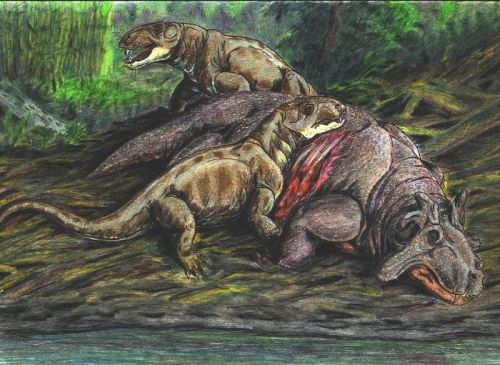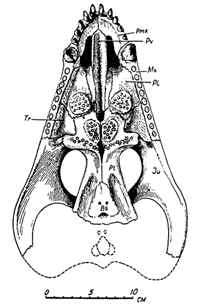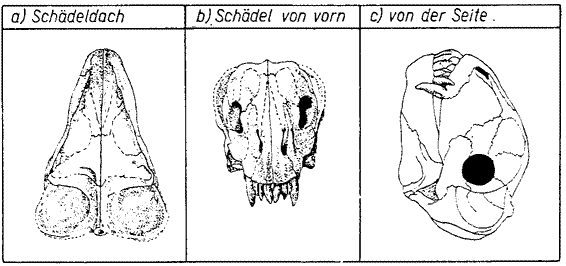
| Palaeos |  |
Therapsida |
| Vertebrates | Anteosauria |
| Page Back | Unit Home | Unit Dendrogram | Unit References | Taxon Index | Page Next |
| Unit Back | Vertebrates Home | Vertebrate Dendrograms | Vertebrate References | Glossary | Unit Next |
Abbreviated Dendrogram
SYNAPSIDA | THERAPSIDA |--Biarmosuchia `--+--Dinocephalia | |--Stenocybus | |--Estemmenosuchidae | |--Anteosauria | | |--Archaeosyodon | | `--+--Brithopodidae | | | |--Chthomaloporus | | | `--Brithopus | | `--+--Deuterosaurus | | `--Anteosauridae | `--Tapinocephalia `--+--Anomodontia | |--Venyukovioidea | `--Dicynodontia `--Theriodontia |--Gorgonopsia `--+--Therocephalia `--CYNODONTIA |
Contents
Index |

The family "Brithopodidae" was erected by Efremov in 1954 to include the carnivorous therapsids of the Russian Tatarian (Late Permian) Copper Sandstones and other Cis-Uralian localities, including both those of the Cis-Uralian Dinocephalian Complexes and the Isheevian Dinocephalian Complex. In the same year, Boonstra created the family Anteosauridae for the giant carnivorous dinocephalians of the South African Lower Beaufort (Tapinocephalus Zone). In his 1962 monograph on American and Russian Late Permian reptiles, Olson (1962) places the distinct herbivorous "brithopodid" Deuterosaurus in a family of its own. For several decades these three families were considered distinct if closely related. In her 1988 monograph on the "Anomodonta," King (1988) suggested a subfamily distinction, although rejecting the status of the Deuterosauridae. The current cladistic-based tendency is of course to do away with these Linnean taxa altogether. Hence our non-committal title, Anteosauria.
The basic technical diagnosis of the Anteosauria (Brithopodidae), which includes the three subfamilies, is as follows: A group of primitive carnivorous dinocephalians. The skull is high and narrow. The palatal teeth - the teeth on the roof of the mouth, a feature of many Paleozoic tetrapods - are enlarged and usually confined to a kidney-shaped cluster on each palatine (near the outer tooth row). Any palatal teeth on the pterygoid flange are reduced. The marginal teeth (teeth in the "normal" position) are of three types: anterior (front or incisor), canine, and cheek teeth. Here we have the further differentiation of tooth types along the line to the mammalian condition. The incisors (the teeth at the front) each have a small ledge or "heel", a distinctive dinocephalian feature that only the estemmenosuchids lack. The canine is very large in all anteosaurs, even the herbivorous ones. There are usually about ten cheek teeth (although the number is very variable, depending on age and tooth replacement), possessing bulbous crowns. The teeth may decrease in size from front to rear. There is a "step" or upturning in the premaxilla bone of the upper jaw, so the front of mouth curves strongly upwards. A somewhat similar "kink" (possibly a mobile joint) can be seen among some archosaurs such as proterosuchids and coleophysid dinosaurs. The postorbital bone and bar behind the eye are large, modified to produce an area for the attachment of the superficial adductor jaw muscles on the outer surface of skull. There is a tendency towards pachyostosis, the thickening of the roof of the head that is a common dinocephalian characteristic, perhaps indicative of "head-butting" intra-specific behavior (rivalry for mates and/or territory). This takes the form of a tuberosity around the pineal opening, in advanced forms as a bony "boss" (almost like a low mound). There is a large canal for pineal organ ("third eye", probably tied in with the animal's diurnal and seasonal cycles). The shoulder girdle is fairly light, with a narrow interclavicle, clavicle, and scapular blade. The femur (thigh bone) is slender and curved. These were, in spite of their size, probably quite agile animals.
The stance of a typical anteosaur, such as Titanophoneus was primitive. Rather than the limbs being drawn in under the body, the stance was more sprawling. Olson (1962) notes that the Russian dinocephalian assemblages indicate environments tied to water, and Boonstra considered that the roughly contemporary Anteosaurus was a slinking crocodile-like semi-aquatic form. The long tail, weak limbs, and sprawling posture do indeed suggest some sort of crocodile-like existence. However the thickened skull-roof indicates that these animals were quite able to get about on land, if they were to practice the typically dinocephalian head-butting behavior. All other head-butters - pachycephalosaurian dinosaurs, titanothere ungulates, and goats - were or are completely terrestrial. Perhaps these animals spent some time in the water but were active on land during the mating season, and probably quite able to get about on land to hunt for prey (consider a modern sprawling/ambush predators such as the komodo "dragon" lizard).
The large anteosaurs were efficient predators, more specialized than earlier and more primitive Biarmosuchid and Eotitanosuchid carnivorous therapsids, as the temporal opening behind the eye socket was larger, indicating a greater muscle mass available for closing the lower jaw. And with skull lengths of 50 to 80 cm, overall lengths of 3 to 5 meters, and live weights of upto 500 kg, animals like Titanophoneus, Doliosauriscus, and Anteosaurus played the role of top predator in the terrestrial tetrapod assemblages of the Capitanian epoch that the large Eotitanosuchus did during the preceding late Roadian and early Wordian epoch, and the 3 meter long Dimetrodon did during the Early Permian.
A full understanding of Anteosaur phylogeny has to await greater scrutiny of the available remains. Much of the Russian material is fragmentary, and a lot of this will no doubt turn out to be synonymous with the better known forms. It was originally thought that the earliest anteosaur was the very fragmentary American Eosyodon Olson, of Latest Kungurian age. It now seems that all of the proto-therapsids Olson described in his monograph are chimeras - mostly misinterpretations of caseid pelycosaurs (Sidor & Hopson 1995). That leaves the Russian Ocher fauna from Ezhovo (probably early Wordian age) as the oldest known anteosaurs. Two species are known from this period. Significantly, Archaeosyodon is known only from the skull, and Chthomaloporus only from postcrania. It is not unlikely that these two thus represent the same animal. The skull is typical of a fairly primitive anteosaur and indicates a reasonably large animal - perhaps a large predator intermediate in size between the dog-sized Biarmosuchus, the large Eotitanosuchus, and the huge Ivantosaurus, both of which were contemporary. The postcrania however include a pelvic girdle quite unique from that of other anteosaurs, indicating that this type represents a side-branch rather than a direct ancestor.
By the late Wordian / early Capitanian (late Kazanian - Bashkirian subzone), perhaps several million years later, the gigantic Eotitanosuchid super-predators are gone, along with most of their estemmenosuchid herbivore prey (perhaps the victims of a minor mass-extinction) and only a few smallish anteosaurs remain. They seem to have diverged into at least two distinct lineages - the primitive carnivorous types (Syodon and Brithopus - Brithopididae) and the more specialized herbivores (Deuterosaurus). The latter perhaps filled the ecological role vacated by the Estemmenosuchids.
A million or so years later, all the animals had grown in size, evolving into bigger and bigger types. A big species of Brithopus was joined by a giant Admetophoneus (subfamily Anteosaurinae), and the deuterosaurs had also increased in size, and were now existing alongside the big advanced tapinocephalid herbivores. These animals are by and large a lot bigger than those that existed during Bashkirian time.
By the time of the forms that have been found at Isheevo, the continuing basal primitive types like Syodon and Brithopus, and the advanced giant carnivorous forms like Titanophoneus and Doliosauriscus, are flourishing. The deuterosaurs are gone, perhaps replaced by the tapinocephalids. This seems to be the golden age of anteosaur diversity, and indeed of the dinocephalians in general. The South African Anteosaurus (Tapinocephalus zone), a representative of the titanophonine- doliosaur lineage (subfamily Anteosaurinae), seems to have existed at this time and also slightly later.
It is interesting that whereas in the South African temperate zone fauna there is only one anteosaurian predator (the giant Anteosaurus), in the tropical Isheevo fauna (yes, at the time Russia was located in the tropics!) there are four. Perhaps there were more ecological niches in the tropics for these animals. Perhaps some of the species will turn out to be synonyms or juveniles of other forms. Perhaps the smaller Russian anteosaurs like Syodon filled the same ecological niche as the similarly sized Titanosuchus did in the temperate regions. Much still remains to be known about these amazing animals. MAK000902. (revised MAK091114)
Anteosauria: Sinophoneus, Stenocybus
Range: Middle Permian to Late Permian of China, South Africa & Russia.
Phylogeny: Dinocephalia: Tapinocephalia + *: Archaeosyodon + (Brithopodidae + (Deuterosaurus + Anteosauridae)).
Characters: skull long, high and narrow [BS00]; skull pachyostosis common, especially around orbital rims & parietals [BS00]; premaxilla with "step" or upturning, so the front of mouth curves strongly upwards; pineal foramen large, with pronounced tuberosity; temporal fenestra well open dorsally [BS00]; palatal teeth enlarged and usually confined to kidney-shaped cluster on palatines; postorbital bone and bar large, modified to area for external attachment of superficial adductors; any teeth on pterygoid flange reduced; marginal teeth include incisors, canines, and cheek teeth; incisors with small ledge or "heel" [BS00]; canines very large [BS00]; usually about ten cheek teeth; (rather variable, dependent on age and tooth replacement); cheek teeth with bulbous crowns [BS00]; teeth may decrease in size distally; shoulder girdle is fairly light, with a narrow interclavicle, clavicle, and scapular blade; femur slender and curved; mostly carnivorous.
References: Battail & Surkov (2000) [BS00]; Rubidge & Sidor (2001) [RS01].
Note: possibly paraphyletic [RS01]. ATW020219.
 Archaeosyodon:
A. praeventor Tchudinov 1960.
Archaeosyodon:
A. praeventor Tchudinov 1960.
Range: Middle Permian to Late Permian of Russia. (Ochersky area, near Ezhovo locality. Upper Kazanian)
Phylogeny: Anteosauria: (Brithopodidae + (Deuterosaurus + Anteosauridae)) + *.
Characters: medium (1.5-2.0 m) anteosaur; skull is massive & rather tall [BS00]; maxillary surfaces sculpted [BS00]; dorsal margin of orbits & fronto-parietal region strongly thickened; temporal openings broadly open dorsally; palate primitive, especially in arrangement of palatal teeth & anterior position of short, deep, choanae [BS00]; palatines and pterygoid flanges with numerous teeth [BS00]; upper canines short & recurved [BS00]; carnivorous.
Note: may be a primitive titanosuchid, not an anteosaur.
Links: PaleoNET | Библиотека.
References: Battail & Surkov (2000) [BS00]. ATW030518.
Brithopodidae: (= Brithopodinae)
Range: Middle Permian to Late Permian of Russia.
Phylogeny: Anteosauria:: (Deuterosaurus + Anteosauridae) + *: Chthomaloporus + Brithopus.
Characters: quadrate condyles narrowed anteroposteriorly. ATW020524.
Chthomaloporus: C. lenocinator Tchudinov 1964b.
Range: Middle Permian to Late Permian of Russia.
Phylogeny: Brithopodidae: Brithopus + *.
Characters: pelvic girdle lightly built [BS00] [K88]; acetabula closely spaced [BS00] [K88]; ischiadic symphysis well developed on anterior edge of ilia [BS00] [K88]; fused sacral vertebrae [BS00] [K88]; a powerful finger-shaped process on anterior edge of ilium [K88].
References: Battail & Surkov (2000) [BS00]; King (1988) [K88]. ATW020524.
Brithopus: (= Orthopus = Rhopalodon = Dinosaurus = Eurosaurus) B. bashkyricus Efremov 1954; B. fischeri Eichwald 1860; B. ponderus Efremov 1954; B. priscus Kutorga 1838.
Range: Middle Permian of Russia.
Phylogeny: Brithopodidae: Chthomaloporus + *.
Characters: fairly large (length 2.5 to 3 m) [K88]; choanal depression deep [BS00]; pterygoid flanges with row of teeth [BS00]; small palatal teeth on palatines [BS00]; postcanine teeth 9-10 [BS00] [K88]; shoulder girdle massive [K88]; glenoid somewhat screw-shaped (limited range of movement) [K88]; humerus with high supinator crest [BS00]; femur with strong 4th trochanter & short adductor crest [BS00].
Links: 0521554764WS.pdf (historical interest)
References: Battail & Surkov (2000) [BS00]; King (1988) [K88].
Note: all extremely scrappy material. ATW020524.
 Deuterosaurus:
(= Eurosaurus = Mnmeiosaurus = Uraniscosaurus) D.
biarmicus Eichwald 1860.
Deuterosaurus:
(= Eurosaurus = Mnmeiosaurus = Uraniscosaurus) D.
biarmicus Eichwald 1860.
Range: Late Permian of Russia.
Phylogeny: Anteosauria::: Anteosauridae + *.
Characters: Skull nearly as high as long (about 230 mm) [BS00]; pachyostosis reduced [BS00] & localized just anterior to orbital margin; jaw hinge displaced slightly anterior, but well below lower tooth row [BS00]; incisors with well-developed heels [BS00]; lower tusks (canines?) with longitudinal facets on enamel; postcanine teeth small [BS00]; postcanine teeth laterally flattened; complex crown structure in palatal teeth; tibia large with rounded and massive head; femur similar to that of sphenacodontids, with incipient development of trochanter major.
Note: Huxley thought Deuterosaurus was a dinosaur (see links below). Consequently, it is more famous today for not being a dinosaur, than for any quality it posessed as an anteosaur.
Image: Deuterosaurus skull in palatal, anterior and lateral views from Müller ("1968" (=1985?)).
Links: Triassic Dinosauria; On the Classification of the Dinosauria (1870); Revision of the Pelycosauria of North America.
References: Battail & Surkov (2000) [BS00]. ATW030521.
| Page Back | Unit Home | Page Top | Page Next |
checked ATW040710